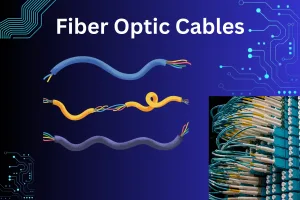What Is Fiber Optic Cable?
A network cable with glass fibre lines covered in a shielded housing is called a fibre optic cable. Moreover, they are meant for high-performance, long-distance data networking and connectivity.
Fibre optic links offer incredible speed and higher data transfer lengths than regular lines. Additionally, fibre optic cables power most telephones, cable television, and web servers worldwide.
Furthermore, Fibre optic cables use light pulses produced by tiny lasers or light-emitting substances to transport information.

types of fiber optic cables in canada
How Fiber Optic Cables Work
A fibre optic cable comprises one or more glass wires that are only slightly larger than the hair of a human being. The centre, which forms a path for lights to travel, lives in the middle of each line. To prevent data loss, a layer of glass known as covering is used to wrap around the core. Additionally, this covering helps to reflect light inside and enables it to move around cable twists.
Additionally, Optical fibre cables come in two main kinds: only one mode and multi-mode. While multi-mode optical fibre links use LEDs, single-mode fibre fibre creates light using fragile glass strands and a beam of light.
The wave Divide Multiplying methods are frequently employed in single-mode fibre networks to increase the strand’s ability to handle more data flow. Moreover, with wavelength division mixing (WDM), the light of various colours can be mixed and then later divided, leading to the effective transmission of several data channels through just one light interval.
Advantages of Fiber Optic Cables
Fiber cables offer several advantages over long-distance copper cabling. Additionally, fibre cables have many benefits compared to wiring made of copper across long distances. Furthermore, fibre optics support a larger capacity.
Moreover, a fibre cable can readily move greater network bandwidth than a copper wire of similar thickness. Again, typical fibre connections have 10 Gbps, 40 Gbps, and 100 Gbps speeds.
Additionally, the requirement for boosters for the signal is reduced since light can travel via fibre cables over significantly longer distances without losing strength.
Moreover, the disturbance is less likely than not with a fibre optic cable. Additionally, it is essential to protect a copper network cable from electromagnetic waves.Furthermore, even if this shield is sound, it is insufficient to stop noise when many lines are arranged close to one another.
Fiber Networks, Other Deployments, and Fiber to the Home
- While most Fibre optic deployments provide long-distance connections across cities and nations, some home internet service providers have tried to expand their fibre networks into rural areas so that homes can access them directly. These kinds of installations are referred to as the final mile by providers and industry experts.
- Two of the most well-known fibre suppliers to the house are Telecom’s services . Such providers may enable giga internet speeds across couples. They frequently do, however, also sell customers bundles with lower capacity. Several home-consumer packages are often shortened with several letters.
- Direct Fibre is defined as Fibre that is connected locally to a single customer after leaving the central office. Although straight Fibre is more costly, it offers the largest capacity.
Spread fibre: Similar to direct thread, it divides into additional optical fibres for near customers as it gets closer to their location.
Conslusion:
Fibre optic cables offer several advantages over long-distance copper cabling. Additionally, they have a larger capacity and can support greater network bandwidth. Moreover, the need for signal boosters is reduced as light can travel longer distances without losing strength. Furthermore, fibre optic cables are less susceptible to disturbances and electromagnetic interference than copper cables.
Fibre optic networks have been deployed for long-distance connections across cities and nations. Additionally, some internet service providers have expanded their fibre networks into rural areas, allowing homes to access high-speed internet connections directly.
Different types of fiber installations include Direct Fiber and Spread Fiber. Each type offers varying levels of connectivity and capacity.
Overall, fibre optic cables provide reliable and high-performance connectivity, making them a preferred choice for long-distance communications and internet services.


